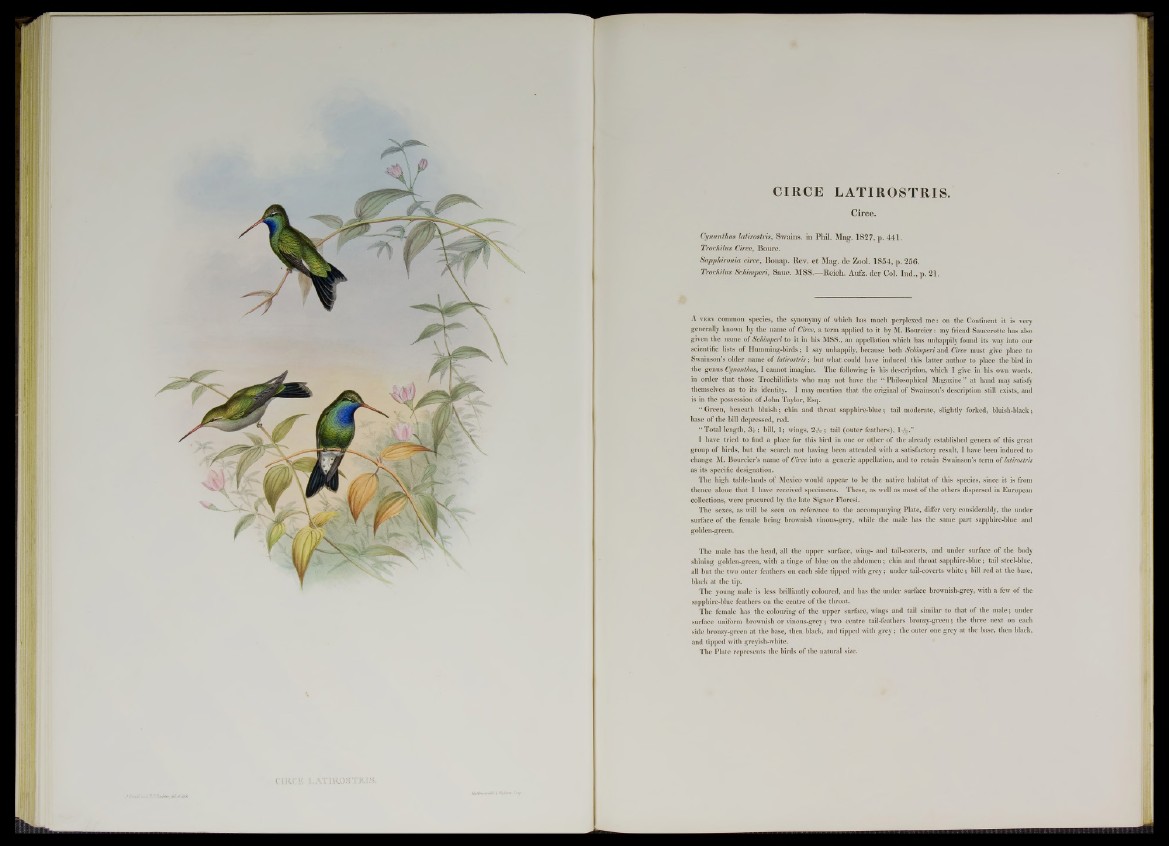
CIRCE LATI ROSTRI S.
Circe.
Cynanthus latirostiis, Swains, in Phil. Mag. 1827, p. 441.
Trochilus Circe, Bourc.
Sapphironia dree, Bonap. Rev. e t Mag. de Zool. 1854, p. 256.
Trochilus Schimperi, Sauc. MSS.—Reich. Aufz. der Col. In d ., p. 21.
A v e r y common species, the synonymy of which has much perplexed me: on the Continent it is very
generally known by the name of Circe, a term applied to it by M. Bourcier: my friend Saucerotte has also
given the name of Schimperi to it in his MSS., an appellation which has unhappily found its way into our
scientific lists of Humming-hirds; I say unhappily, because both Schimperi and Circe must give place to
Swainson’s older name of latirostris; but what could have induced this latter author to place the bird in
the genus Cynanthus, I cannot imagine. The following is his description, which I give in his own words,
in order that those Trochilidists who may not have the “ Philosophical Magazine ” at hand may satisfy
themselves as to its identity. I may mention that the original of Swainson’s description still exists, and
is in the possession of John Taylor, Esq.
“ Green, beneath bluish; chin and throat sapphire-blue; tail moderate, slightly forked, bluish-black;
base of the bill depressed, red.
“ Total length, bill, l j wings, 2-fr; tail (outer feathers), 1-jV.”
I have tried to find a place for this bird in one or other of the already established genera of this great
group of birds, but the search not having been attended with a satisfactory result, I have been induced to
change M. Bourcier’s name of Circe into a generic appellation, and to retain Swainson’s term of latirostris
as its specific designation.
The high table-lands of Mexico would appear to be the native habitat of this species, since it is from
thence alone that I have received specimens. These, as well as most of the others dispersed in European
collections, were procured by the late Signor Floresi.
The sexes, as will be seen on reference to the accompanying Plate, differ very considerably, the under
surface of the female being brownish vinous-grey, while the male has the same part sapphire-blue and
golden-green.
The male has the head, all the upper surface, wing- and tail-coverts, and under surface of the body
shining golden-green, with a tinge of blue on the abdomen; chin and throat sapphire-blue; tail steel-blue,
all but the two outer feathers on each side tipped with grey; under tail-coverts white; bill red at the base,
black at the tip.
The young male is less brilliantly coloured, and has the under surface brownish-grey, with a few of the
sapphire-blue feathers on the centre of the throat.
The female has the colouring of the upper surface, wings and tail similar to that of the male; under
surface uniform brownish or vinous-grey; two centre tail-feathers bronzy-green; the three next on each
side bronzy-green at the base, then black, and tipped with grey; the outer one grey at the base, then black,
and tipped with greyish-white.
The Plate represents the birds of the natural size.